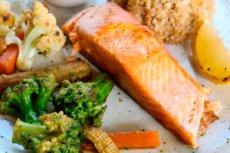Nye publikasjoner
Antioksidanter bekjemper problemer med kvinners reproduktive system forårsaket av et fettrikt kosthold
Sist anmeldt: 02.07.2025

Alt iLive-innhold blir gjennomgått med medisin eller faktisk kontrollert for å sikre så mye faktuell nøyaktighet som mulig.
Vi har strenge retningslinjer for innkjøp og kun kobling til anerkjente medieområder, akademiske forskningsinstitusjoner og, når det er mulig, medisinsk peer-evaluerte studier. Merk at tallene i parenteser ([1], [2], etc.) er klikkbare koblinger til disse studiene.
Hvis du føler at noe av innholdet vårt er unøyaktig, utdatert eller ellers tvilsomt, velg det og trykk Ctrl + Enter.

I en systematisk oversikt publisert i tidsskriftet Frontiers in Nutrition presenterte forskere fra Italia en omfattende oversikt over effektene av biologiske matriser med antioksidantegenskaper på å redusere komplikasjoner i det kvinnelige reproduksjonssystemet forårsaket av fettrik kosthold.
Kaloririke dietter, inkludert de som er rike på mettet fett og transfett, kan påvirke det kvinnelige reproduksjonssystemet negativt ved å forårsake produksjon av reaktive oksygenforbindelser (ROS) og som et resultat indusere oksidativt stress. Dette kan føre til uregelmessige eggløsningssykluser og for tidlig eggstokksvikt.
Kostholdsindusert ROS-produksjon kan påvirke blodtilførselen til reproduksjonsorganene og forstyrre hypothalamus-hypofyse-ovarie-aksen. Disse prosessene kan forårsake hormonell ubalanse, indusere insulinresistens og hyperleptinemi, fremme kronisk lavgradig betennelse, påvirke eggcellekvaliteten og svekke embryoimplantasjon i livmoren og opprettholdelse av svangerskapet.
Biologiske matriser som kan påvirke det kvinnelige reproduksjonssystemet positivt inkluderer karbosykliske sukkerarter, fytonæringsstoffer, organosvovelforbindelser, hormoner, nevropeptider, organiske syrer og vitaminer. Disse matrisene inneholder hovedsakelig en rekke antioksidanter som bidrar til å redusere ROS-indusert oksidativ skade.
I denne systematiske oversikten vurderte forfatterne effektiviteten av biologiske matriser i å forhindre ovariekomplikasjoner forårsaket av oksidativt stressindusert av fettrik diett. De analyserte 121 studier publisert i fagfellevurderte engelskspråklige tidsskrifter.
Antioksidanter avledet fra biologiske matriser og deres effekter på oksidativt stress indusert av fettrik diett
Follikulogenese er prosessen der primordiale kimceller modnes til oocytter i follikler, og er avgjørende for optimal funksjon av det kvinnelige reproduksjonssystemet.
Et fettrikt kosthold kan forårsake oksidativ skade på eggstokkene, spesielt påvirke follikkelutvikling, overlevelse og produksjon av hormoner som er nødvendige for å regulere follikulogenese. Disse faktorene kan påvirke eggcellekvaliteten og forstyrre embryoutviklingen.
I gnagermodeller av oksidativt stress indusert av et fettrikt kosthold, bevarte et kosthold som inneholdt en kombinasjon av to fytonæringsstoffer, bygg og dadler, eggstokkfollikler, økte utviklingen og proliferasjonen deres, gjenopprettet eggstokkstroma og økte nivåene av endogene enzymatiske antioksidanter.
Disse positive resultatene kan forklares med den økte aktiviteten til flavonoider og fenoliske antioksidantegenskaper som finnes i ferulinsyre, kaempferol, malvidin, kaffesyre og quercetin-derivater.
I musemodeller med oksidativt stress indusert av fettrik diett aktiverte et tymokinonholdig kosthold AMPK/PGC1α/SIRT1-signalveien, noe som økte antioksidantstatusen, reduserte betennelse og forbedret mitokondriefunksjonen. Disse endringene var assosiert med økt antall tidlige follikler og forbedret oocyttkvalitet.
En diett som inneholdt nevropeptidet phoenixin reduserte eggstokkvekten, reduserte periovarielle fettputer, modulerte luteiniserende hormon (LH) reseptorpositivitet hos gnagere, og reduserte ovariell apoptose og betennelse hos gnagere som fikk et fettrikt kosthold.
Hos overvektige rotter reduserte et multiantioksidanttilskudd som inneholdt en organosvovelforbindelse, fytonæringsstoffer, vitamin E og koenzym Q10 ovariebetennelse og follikulær atresi og lindret fedmeindusert infertilitet.
Hos rotter som ble fôret med et fettrikt kosthold, gjenopprettet et kosthold som inneholdt eplecidereddik og feniksin hormonbalansen, økte follikulogenesen og forbedret antioksidantresponsen i eggstokkene.
En diett som inneholdt ferulinsyre, kaempferol, malvidin, koffeinsyre og quercetin-derivater økte nivåene av både enzymatiske og ikke-enzymatiske antioksidanter hos rotter som fikk kosthold med høyt fettinnhold, noe som resulterte i beskyttelse av oocytter mot DNA-skade.
På samme måte reduserte MitoQ10-tilskudd oksidativt stress indusert av fettrik diett og forbedret mitokondriefunksjonen, dempet DNA-skade og bevarte oocyttkvaliteten.
Organosvovelforbindelser har vist effekt i å lindre infertilitet forårsaket av fettrik diett. Kostholdsintervensjoner som inneholder ferulsyre, kaempferol, malvidin, koffeinsyre og quercetin-derivater, samt kombinert bruk av myo-inositol og α-liponsyre, har vist effekt i å beskytte mot forstyrrelser i eggstokksyklusen og redusere oksidativt stressinduserte degenerative forandringer i eggstokkene.
Samlet sett indikerer eksisterende litteratur at biologiske matriser som antioksidanter effektivt kan redusere antall atretiske follikler, betennelse og ovariell apoptose. Dette støttes av reduksjonen i eggstokkvekt, reduksjonen i periovarielle fettputer og modulering av LH-reseptorpositivitet.
Klinisk betydning av biologiske matriser som antioksidanter
Assistert befruktning regnes som en tradisjonell metode for behandling av infertilitet. Denne metoden kan imidlertid ikke effektivt eliminere hovedårsakene til infertilitet forbundet med et fettrikt kosthold. Biologiske matriser som antioksidanter har vist lovende resultater i behandlingen av disse problemene.
Omega-3-fettsyrer og vitamin B12 har vist seg å være effektive i å redusere symptomer på endometriose, en kronisk hormonrelatert inflammatorisk sykdom som rammer kvinner i reproduktiv alder.
Resultater fra randomiserte kontrollerte kliniske studier fremhever effektiviteten av vitamin E og C i å redusere bekkensmerter og betennelsesmarkører i peritonealvæsken.
Biologiske matriser, inkludert vitamin A, vitamin B1, vitamin B6, vitamin B12, vitamin C, vitamin D3, vitamin E, niacinamid og folsyre, har vist seg å være effektive for å forbedre graviditetsrater hos kvinner med polycystisk ovariesyndrom (PCOS).
Behandling med resveratrol hos pasienter med PCOS har vist seg å forbedre kvaliteten på eggceller og embryoer. Tilsvarende har behandling med vitamin D og E vist seg å øke henholdsvis implantasjonsrater og generell graviditetssuksess.
